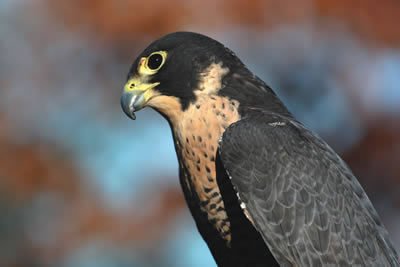Peregrine Falcon
Parth Kansara, CC BY 4.0, via Wikimedia Commons
The adult peregrine has bluish gray wings, a pale underbelly, and a black head.

Design
As with other birds of flight, the falcon is designed with hollow bones, a lightweight beak, and air sacs that connect to the airway. These design features along with its feathers and wing structure make it a capable flyer. The peregrine falcon may teach its young to hunt by dropping dead prey to its flying young who then must grasp it while in flight. This was not part of their behavior until after the Fall of man.
Features
- The adult peregrine has bluish gray wings, a pale underbelly, and a black head.
- Immature peregrine falcons tend to be darker and browner in color.
Fun Facts
- The peregrine falcon may migrate distances greater than 15,500 miles (25,000 km).
- Nests of these falcons have been seen on tall buildings even in cities. They prefer to place them at great heights, mostly on cliffs.
- The peregrine falcon can reach speeds up to 200 mph (322 km/h) when diving after its prey.
Created Kind Members
Prairie falcon, American kestrel
CLASS: Aves (birds)
ORDER: Falconiformes (diurnal birds of prey)
FAMILY: Falconidae (falcons)
GENUS/SPECIES: Falco peregrinus
Size: Wingspan: between 3 and 4 ft (1–1.1 m)
Weight: Average 2 lbs (0.9 kg)
Original Diet: Plants
Present Diet: Primarily smaller birds, but also small mammals and insects
Habitat: Found in open country near cliffs, on all continents except for Antarctica
Zoo Guide
Make your next visit to the zoo more than just fun—make it factual and fascinating too! You could even start a personal “creation zoo tours” ministry. Featuring more than 100 animals, our long-awaited Zoo Guide includes beautiful pictures and explores the amazing facts and design features that point to our awesome Creator. Excellent gift for any one who loves animals!
Browse Kids Book- © 2025 Answers in Genesis
- Privacy Policy
- Contact
- About

